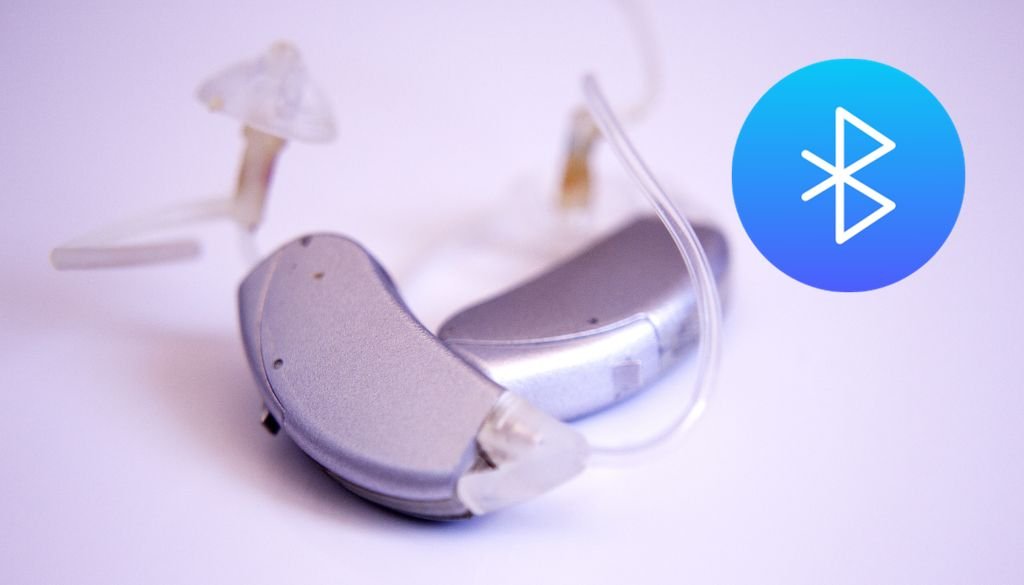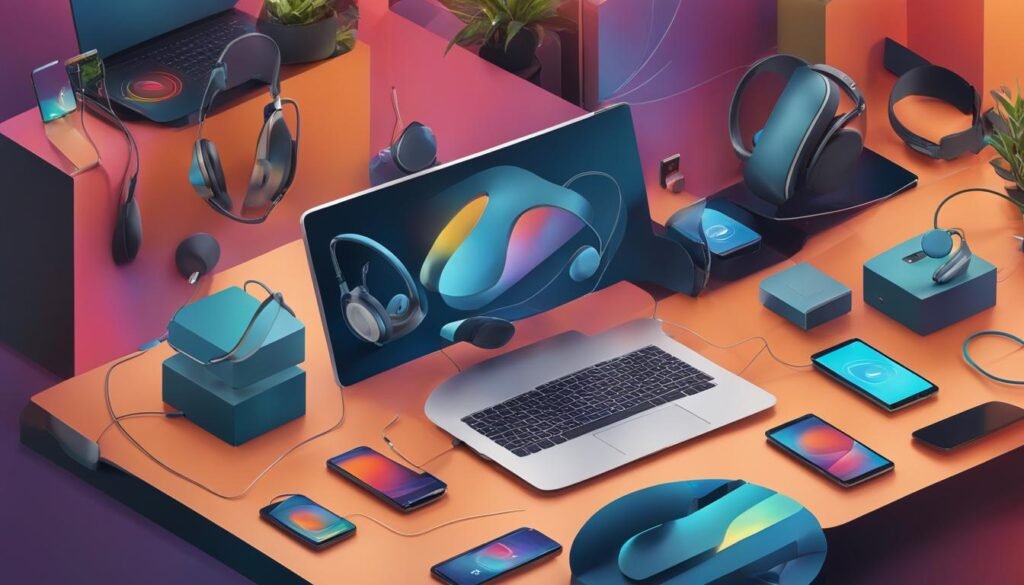Why is Only One Hearing Aid Pairing with My iPhone?” If you encounter this issue, you’re not alone; it doesn’t have to be frustrating. We’re here to assist you in troubleshooting and resolving this common problem. In this guide, we’ll explore the reasons behind this occurrence and offer detailed instructions to help you fix it.

There could be several factors contributing to this issue. It’s crucial first to ensure that your hearing aids are correctly paired with your iPhone. Here are the simple steps you can follow:
- Go to Settings > Bluetooth and make sure Bluetooth is turned on.
- Navigate to Settings > Accessibility > Hearing Devices. Then, turn your hearing aids off and back on again.
- Wait for your hearing devices to appear below MFi Hearing Devices. Once they do, tap the name to respond to the pairing requests.
- Be patient, as pairing can take up to 60 seconds. When the process is complete, you will hear a series of beeps and a tone. Additionally, a checkmark will appear next to the hearing devices in the Devices list.
Remember, you only need to pair your devices once. After the initial setup, they will automatically reconnect to your iPhone when turned on.
If you’ve followed these steps but still face issues with hearing aid pairing, our guide continues with more troubleshooting solutions and additional information about iPhone compatibility with hearing aids.
Key Takeaways:
- Ensure Bluetooth is turned on, and follow the pairing steps to connect your hearing aids to your iPhone.
- If you’re still experiencing pairing issues, check if your hearing aids are already paired with another device and update the firmware.
- Not all hearing aids are compatible with iPhones, so choose “Made for iPhone” (MFi) devices for seamless integration.
- To use your hearing aids with multiple devices, ensure they are signed in with the same Apple ID and connected to the same Wi-Fi network.
- If you encounter other common hearing aid issues, such as one aid not working or audio streaming problems, try troubleshooting or seek professional help.
Troubleshooting Hearing Aid Pairing Issues
Experiencing difficulties with hearing aid pairing can be frustrating, but solutions are available to help you fix connection problems. Here are a few troubleshooting steps you can try:
- Ensure that your hearing aids are not paired with another nearby device, such as a Mac or iPad. Disable Bluetooth on those devices temporarily while you pair your hearing aids with your iPhone.
- Check if your hearing devices are updated with the latest firmware from the manufacturer. Outdated firmware can sometimes cause pairing issues, so keeping them up to date is crucial.
- If the previous steps don’t resolve the problem, consider contacting your audiologist for assistance or the hearing aid manufacturer’s support. They can provide further guidance and troubleshooting specific to your hearing aids.
Remember, following these troubleshooting steps in the given order is essential to increase the chances of resolving the issue. Patience is critical during the pairing process, as it can take a minute or so for the devices to connect correctly. Following these troubleshooting steps can increase the chances of successfully pairing your hearing aid with your iPhone.
Quick Tip:
If you encounter difficulties during the pairing process, try restarting your iPhone and hearing aids before pairing them again. Sometimes, a simple restart can help resolve temporary connectivity issues.
Does sinus infection cause hearing loss? Explore the latest Insights
Remember, each hearing aid model may have its unique pairing process, so consult the manufacturer’s instructions or user manual for specific troubleshooting steps. These steps should help you overcome the most common pairing issues and ensure a seamless connection between your hearing aids and iPhone.
iPhone Compatibility with Hearing Aids
When pairing hearing aids with your iPhone, it’s essential to understand the compatibility between the two devices. Not all hearing aids are designed to work seamlessly with iPhones, but there is a solution. Look for hearing devices labeled “Made for iPhone” (MFi). These devices are designed to be compatible with Apple products, ensuring a smooth and hassle-free user experience.
To ensure iPhone compatibility, it’s recommended to check the list of MFi hearing devices and system requirements provided by Apple. This will help you determine if your specific hearing device is compatible with your iPhone and its operating system. Remember that compatibility ratings are not guaranteed, so it’s always a good idea to try the hearing aids with your iPhone before purchasing.
Why Choose MFi Hearing Devices?
MFi hearing devices offer several advantages regarding compatibility with iPhones and other Apple devices. These devices provide a seamless connection, allowing you to easily pair your hearing aids with your iPhone and enjoy the benefits of wireless audio streaming and control through your machine. With MFi hearing devices, you can adjust settings, stream calls and music, and even use your iPhone as a remote control for your hearing aids. This integration between hearing aids and iPhones enhances the user experience and convenience.
In conclusion, if you’re looking for iPhone compatibility with your hearing aids, consider opting for MFi hearing devices. These devices are designed to work with Apple products, ensuring a seamless connection and enhanced user experience. Remember to check the compatibility ratings provided by Apple and try the hearing aids with your iPhone before making a purchase. With the right combination of hearing aids and an iPhone, you can enjoy optimal performance and convenience in your daily life.
Using Hearing Aids with Multiple Devices
If you want to use your hearing aids with multiple devices, such as an iPhone and an iPad, a simple process allows for seamless connectivity. First, ensure that all the devices you want to connect are signed in with the same Apple ID and connected to the same Wi-Fi network. This step is crucial for the devices to communicate with each other and share information about your hearing aid settings.
Once your devices are synced, you can easily switch between them without any hassle. The connection for your hearing aids will automatically switch from one device to another, allowing you to transition your listening experience seamlessly. Whether watching a video on your iPhone or reading an e-book on your iPad, your hearing aids will adapt and provide optimal sound quality for each device.
Using hearing aids with multiple devices has become much easier with technological advancements. You can enjoy a seamless and personalized listening experience across your Apple devices with the correct settings and devices.
Does tinnitus from Viagra go away? Unravel the complexities in our detailed guide, exploring the side effects of this medication and their impact on hearing.
Another advantage of using hearing aids with multiple devices is the ability to sync your hearing aid settings across all devices. Any changes you make to the settings on one device will be automatically synced with your other devices. This means you won’t have to manually adjust the settings each time you switch devices, saving you time and effort.
Maintaining a consistent listening experience
By using your hearing aids with multiple devices, you can ensure a consistent listening experience no matter which device you are using. Whether on a phone call, listening to music, or watching a movie, your hearing aids will seamlessly adapt to provide you with the best sound quality.
- Connect your devices to the same Wi-Fi network and sign in with the same Apple ID.
- Switch between devices without any interruption or re-pairing.
- Sync your hearing aid settings across all devices for a personalized experience.
Overall, using hearing aids with multiple devices offers convenience and flexibility, allowing you to enjoy the benefits of hearing aids across all your Apple devices.
Troubleshooting Common Hearing Aid Issues
Hearing aids, like any electronic device, can encounter various issues that may affect their performance. Here are some common problems you may encounter with your hearing aids and troubleshooting steps to help resolve them:
- One Hearing Aid Not Working
If you notice that one of your hearing aids is not functioning correctly or producing sound, there could be a few reasons behind it. Firstly, ensure that the battery is not dead or low on power. Try replacing the battery with a fresh one to see if that resolves the issue. If the problem persists, check for any clogs or debris in the receiver tube or microphone opening and clean them gently using a soft brush or cloth. If the problem persists, it may be a technical issue requiring professional assistance. Reach out to your audiologist or the hearing aid manufacturer for further guidance.
- Hearing Aid Battery Issues
Hearing aid batteries can sometimes drain faster than expected. If you notice that one hearing aid’s battery consistently dies before the other, it may indicate an issue with the hearing aid itself. Contact your audiologist or the hearing aid manufacturer to determine if the device needs servicing or if there are any specific steps you can take to extend battery life. Additionally, it’s essential to properly store your hearing aids when not in use to prevent unnecessary battery drain.
- Audio Streaming Problems with Hearing Aids
Hearing aids that support audio streaming may occasionally encounter issues when connecting to external devices, such as your iPhone or TV. If you experience audio streaming problems, ensure that your hearing aids are appropriately connected to the device and that the audio source is selected correctly. Verify that the volume is properly adjusted on both the streaming device and your hearing aids. If the problem persists, refer to the manufacturer’s instructions or contact their support team for assistance.
- Other Common Hearing Aid Pairing Problems
Aside from the specific issue of one hearing aid not pairing with your iPhone, users may face other common pairing problems, as mentioned in the previous section. These can include issues with connectivity, intermittent pairing, or difficulties pairing multiple devices. If you encounter any of these problems, refer to the troubleshooting steps provided by your hearing aid manufacturer. They may include resetting the pairing, updating firmware, or adjusting settings on your connected devices.

Following these troubleshooting steps, you can independently resolve common hearing aid issues. However, it’s important to remember that if the problems persist or you’re unsure about any actions, it’s always best to seek assistance from your audiologist or the hearing aid manufacturer. They can provide specific guidance tailored to your hearing aids and help ensure optimal performance and functionality.
Conclusion
Dealing with hearing aid pairing issues can be frustrating, but solutions are available to troubleshoot and resolve common problems. By following the steps outlined in this guide, you can ensure that your hearing aids are correctly paired with your iPhone and that you have optimal compatibility.
If you continue to experience issues despite troubleshooting, you should seek that distance from your audiologist or the hearing aid manufacturer. They can provide personalized support and guidance to address any lingering problems.
Remember, maintaining up-to-date firmware for your hearing devices and conducting regular checks can help prevent future pairing issues. With patience and persistence, you’ll enjoy seamless pairing and optimal performance of your hearing aids with your iPhone.
Frequently Asked Questions
Why is only one hearing aid pairing with my iPhone?
There could be a few reasons behind this issue. First, ensure that your hearing aids are correctly paired with your iPhone by following the steps outlined in the article. If the problem persists, try troubleshooting steps such as disabling Bluetooth on nearby devices and updating your hearing aid’s firmware. Contact your audiologist or the hearing aid manufacturer if all else fails.
How do I troubleshoot hearing aid pairing issues?
To troubleshoot hearing aid pairing issues, follow the steps in the article, such as ensuring correct pairing, checking for nearby devices, and updating firmware. If the problem persists, seek assistance from your audiologist or the hearing aid manufacturer.
Is my hearing aid compatible with my iPhone?
Not all hearing aids are compatible with iPhones. Look for hearing devices labeled “Made for iPhone” (MFi) and check Apple’s list of MFi hearing devices and system requirements for compatibility. It’s recommended to try the hearing aids with your iPhone before making a purchase.
How can I use my hearing aids with multiple devices?
To use hearing aids with multiple devices, ensure that all devices are signed in with the same Apple ID and connected to the same Wi-Fi network. The connection for your hearing aids will automatically switch between devices, and any changes made to the settings will be synced across devices.
What should I do if one hearing aid is not working?
If one hearing aid is not working, replacing the battery with a fresh one often resolves this issue. If the problem persists, contact your audiologist or the hearing aid manufacturer for further assistance.
How do I troubleshoot audio streaming problems with my hearing aids?
Ensure that your hearing aids are properly connected and that the audio source is selected correctly. If the issue continues, consult the manufacturer’s instructions or seek professional help.



